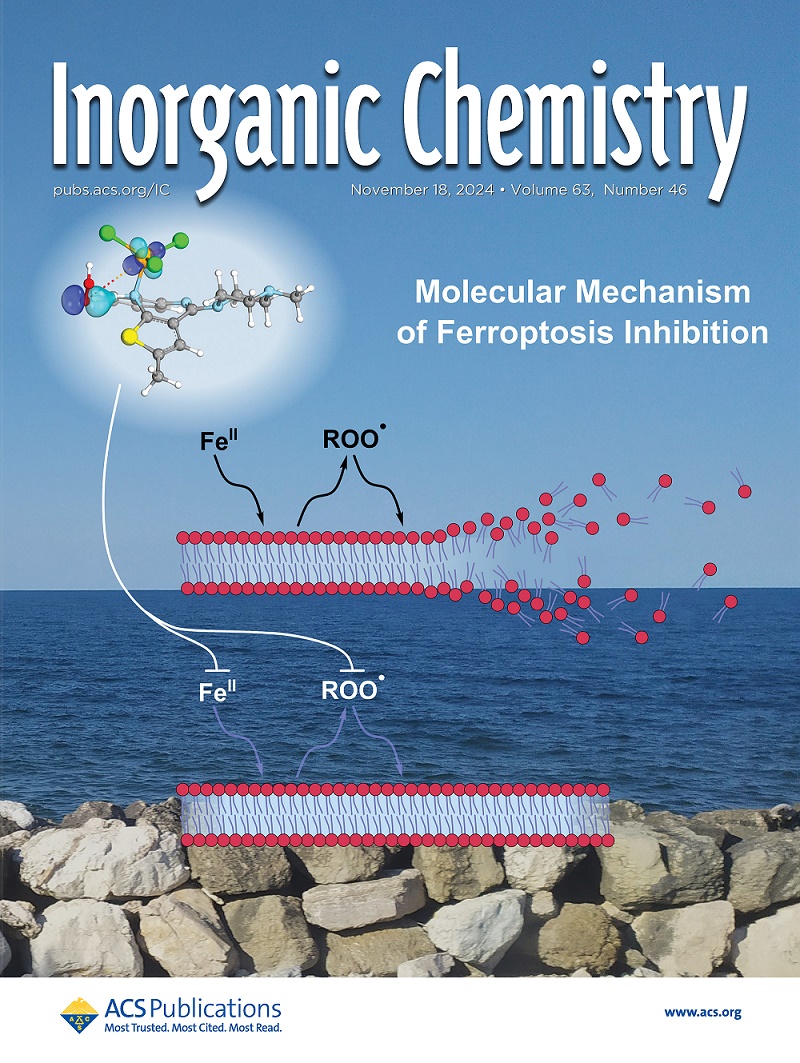IF 4.3
2区 化学
Q1 CHEMISTRY, INORGANIC & NUCLEAR
引用次数: 0
摘要
Au@Prussian-Blue analogue (PBA) core@shell nanoparticles (NPs)是一种用途广泛的纳米结构,具有互补性和形状依赖性,在当前技术中备受关注。然而,由于氰化物对金的高反应性,很少有 PBA 与金 NPs 直接接触合成成功,因此形成各向异性的 Au@PBA NPs 是一项重大的合成挑战。在这里,我们开发出了一种用于合成核@壳 NPs 的可靠方案,这种 NPs 由生长在单个 Au NPs 上的磁性 CsNi[Fe(CN)6] PBA 壳组成,无论其核形态如何(球形、棒形或星形)。具体来说,我们方案的独特之处在于事先用锚定分子对金核进行功能化处理,从而促进 PBA 的生长,同时防止金的蚀刻并保持金属的初始氧化态。这使得铁磁性 NiIIFeIII PBA 能够直接在金 NPs 上生长。此外,通过利用金/PBA 界面的结构错配和各向异性金模板的曲率,我们设法在 PBA 外壳内诱导出大量结构应变。当使用星形金纳米粒子时,最大应变可达 2.0%。这种应变与增加的多晶度相结合,改变了 PBA 的催化特性,使其内在电催化活性提高了 10 倍。本文章由计算机程序翻译,如有差异,请以英文原文为准。

Design of Core@Shell Nanoparticles Based on Gold and Magnetic NiFe Prussian-Blue Analogues Featuring Shape-Dependent Magnetic and Electrochemical Activity
Au@Prussian-Blue analogue (PBA) core@shell nanoparticles (NPs) are highly versatile nanostructures with complementary and shape-dependent properties of interest in the current technologies. However, due to the high reactivity of cyanides toward Au, scarce PBAs have been successfully synthesized in direct contact with Au NPs, leaving the formation of anisotropic Au@PBA NPs as a significant synthetic challenge. Here, we have developed a robust protocol for synthesizing core@shell NPs, composed of a magnetic CsNi[Fe(CN)6] PBA shell grown on individual Au NPs, regardless of the core morphology (spheres, rods, or stars). Specifically, the uniqueness of our protocol lies in the prior Au core functionalization with anchoring molecules that facilitate PBA growth while preventing Au etching and preserving the initial oxidation states of the metals. This has afforded direct growth of ferromagnetic NiIIFeIII PBAs on Au NPs. Moreover, by exploiting the structural mismatch at the Au/PBA interface and the curvature of anisotropic Au templates, we manage to induce a substantial structural strain within the PBA shell. When star-shaped Au nanoparticles are used, a maximum strain of 2.0% is reached. This strain combined with an increased polycrystallinity lead to modifications in the PBA catalytic properties, resulting in a 10-fold improvement in the intrinsic electrocatalytic activity.
求助全文
通过发布文献求助,成功后即可免费获取论文全文。
去求助
来源期刊

Inorganic Chemistry
化学-无机化学与核化学
CiteScore
7.60
自引率
13.00%
发文量
1960
审稿时长
1.9 months
期刊介绍:
Inorganic Chemistry publishes fundamental studies in all phases of inorganic chemistry. Coverage includes experimental and theoretical reports on quantitative studies of structure and thermodynamics, kinetics, mechanisms of inorganic reactions, bioinorganic chemistry, and relevant aspects of organometallic chemistry, solid-state phenomena, and chemical bonding theory. Emphasis is placed on the synthesis, structure, thermodynamics, reactivity, spectroscopy, and bonding properties of significant new and known compounds.
 求助内容:
求助内容: 应助结果提醒方式:
应助结果提醒方式:


